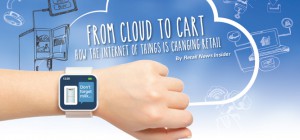 By Retail News Insider
By Retail News Insider
Imagine a toothbrush that tracks your brushing habits and prompts your smartphone to deliver targeted oral care tips. A speaker that not only takes requests to play your favorite songs, but can also add items to your grocery list, turn off lights or lower the heat whenever you ask. Sound like a sci-fi novel or an episode of The Jetsons? Think again. These devices are part of today’s reality—and the growing Internet of Things (IoT). Whether you’re aware of it or not, our mobile devices, household appliances and other electronics are becoming increasingly connected. As more manufacturers make their products “smart” by integrating Bluetooth, Wi-Fi and other networking technologies, so too are more retailers and CPGs looking to get into the IoT game.
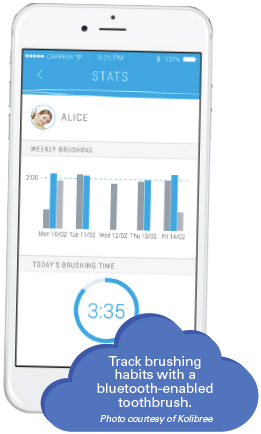 For those who may not be familiar, in its most basic form, the Internet of Things is defined as the collection of everyday objects that are connected to the Internet and/or each other and can send data back and forth. This translates into things like your toothbrush sending data about your brushing habits to your smartphone, as described above, and your smartphone being able to control your home thermostat, television and other smart devices.
For those who may not be familiar, in its most basic form, the Internet of Things is defined as the collection of everyday objects that are connected to the Internet and/or each other and can send data back and forth. This translates into things like your toothbrush sending data about your brushing habits to your smartphone, as described above, and your smartphone being able to control your home thermostat, television and other smart devices.
On the consumer side, the IoT is being driven by consumers’ “always on” lifestyle and growing expectation to be able to access anything from anywhere. Many manufacturers are all too happy to deliver, knowing that they can connect with consumers and collect massive amounts of data from the use of these devices. Naturally, this also holds appeal for many retailers and CPGs.
Today, one of the most common uses of IoT in retail involves beacon technology. Using special Bluetooth transmitters (beacons) placed throughout a shopping center or store, retailers can connect with consumers who have downloaded their mobile app and send targeted messages to consumers’ mobile devices, encouraging them to shop at a nearby store or buy particular products. A leader in the use of this technology is the Regent Street shopping district in London, England. Regent Street is like the Fifth Avenue of the U.K., boasting over 70 million visitors each year.
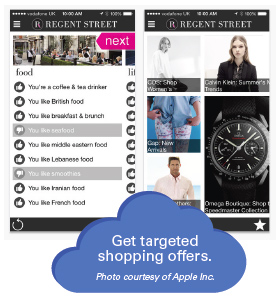 In 2014, the Regent Street collective released an app that links shoppers’ smartwatches, phones and other mobile devices to retailer-installed beacons along its mile-long strip of shops. Within three months of the app’s release, 80 percent of the more than 150 stores on Regent Street had installed these beacons near their entrances. When shoppers download the app, they answer questions about their brand and shopping preferences. Based on these responses, retailers send targeted advertisements and promotions to the shoppers’ mobile devices. As shoppers use the app throughout their visit, retailers can collect more data about which stores they enter and which offers they respond to—enabling more personalized communications in future visits.
In 2014, the Regent Street collective released an app that links shoppers’ smartwatches, phones and other mobile devices to retailer-installed beacons along its mile-long strip of shops. Within three months of the app’s release, 80 percent of the more than 150 stores on Regent Street had installed these beacons near their entrances. When shoppers download the app, they answer questions about their brand and shopping preferences. Based on these responses, retailers send targeted advertisements and promotions to the shoppers’ mobile devices. As shoppers use the app throughout their visit, retailers can collect more data about which stores they enter and which offers they respond to—enabling more personalized communications in future visits.
Another example of the IoT is Amazon’s recently released Dash Button. The Dash Button is an Internet-enabled fob about the size of a USB memory stick that allows Amazon Prime members to place orders for certain products with the simple touch of a button. Prime members order item-specific Dash Buttons via Amazon and set up their preferences first, for example, selecting how much laundry detergent or toilet paper to send in each order. Then they can place the branded Dash Buttons where the items are used or stored (think a Tide button on the washing machine or a Gatorade button on the refrigerator), and press them whenever the supply is running low. This triggers an instant order via Amazon, and a few days later, the items are delivered directly to consumers’ doorsteps. Check out the Dash Button in action:
The ability to blur the lines between the physical and digital realms—and further enhance the omnichannel experience—is one of the key benefits of IoT for retailers. As the Regent Street example shows, it can also help retailers and CPGs learn more about consumers’ individual preferences, allowing for greater personalization. It can also help extend the shopping journey beyond the store and enhance the relationship with the consumer. The ultimate goal, of course, is that it will also drive more sales.
As Dr. Lance Eliot, Vice President of Global IT for Interactions, explains, device manufacturers and retailers as well as those who produce and sell consumables all stand to benefit from the growth of IoT. “IoT will be used to enhance future models of existing products. This will encourage shoppers to replace something that they already have, since they want to get the IoT elements that they do not have in the old version,” says Eliot. In addition, “there will be a price premium attached to IoT-enabled products (initially) and potentially added profits for the CPG and the retailers. Retailers will also benefit from IoT devices ordering products for customers who might not otherwise make the effort to go shopping for them. It will almost become a subscription-like capability that the consumer uses without taking any direct steps to shop.”
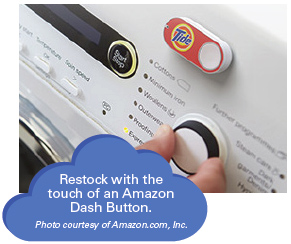 As this last point alludes to, Eliot and many other experts predict that the execution of IoT-enabled shopping will become more seamless as connected household devices become more commonplace. For example, instead of having to press a separate Amazon Dash Button to order more laundry detergent, the washing machine itself will know when your supply is low and automatically order it for you. Your smart refrigerator will know when you’re running low on orange juice or yogurt and automatically add it to your grocery list. When you’re at the store, it will send reminders to your smartwatch to pick up that gallon of milk or carton of eggs to replace the one that’s almost empty, saving you from multiple trips to the store because of forgotten items.
As this last point alludes to, Eliot and many other experts predict that the execution of IoT-enabled shopping will become more seamless as connected household devices become more commonplace. For example, instead of having to press a separate Amazon Dash Button to order more laundry detergent, the washing machine itself will know when your supply is low and automatically order it for you. Your smart refrigerator will know when you’re running low on orange juice or yogurt and automatically add it to your grocery list. When you’re at the store, it will send reminders to your smartwatch to pick up that gallon of milk or carton of eggs to replace the one that’s almost empty, saving you from multiple trips to the store because of forgotten items.
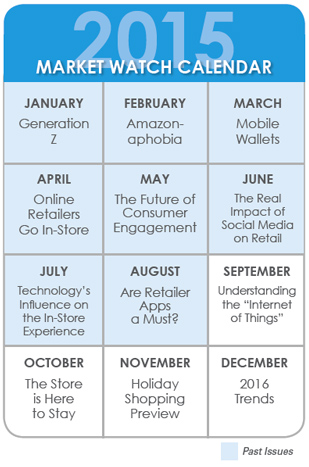 While Eliot cautions that technological advances are often hard to predict, he believes the IoT trend will advance from its infancy to early childhood in the next three to five years. “Shoppers that are the types who like to buy the newest and latest product will be the initial IoT buyers, and will bring along the next wave. That next wave will occur in the timeframe of 5 to 10 years, bringing IoT into the everyday world. At beyond 10 years, the notion of IoT will have become accepted and no longer considered special. It will be just expected as the norm. Everything will be the Internet of Things and so we won’t any longer carry the word ‘Internet’ into it, and just say ‘Things’ and know that it is of course Internet-enabled.”
While Eliot cautions that technological advances are often hard to predict, he believes the IoT trend will advance from its infancy to early childhood in the next three to five years. “Shoppers that are the types who like to buy the newest and latest product will be the initial IoT buyers, and will bring along the next wave. That next wave will occur in the timeframe of 5 to 10 years, bringing IoT into the everyday world. At beyond 10 years, the notion of IoT will have become accepted and no longer considered special. It will be just expected as the norm. Everything will be the Internet of Things and so we won’t any longer carry the word ‘Internet’ into it, and just say ‘Things’ and know that it is of course Internet-enabled.”
By 2020, research firm Gartner predicts there will be nearly 26 billion smart and connected products (not including smartphones and tablets) in use. That’s about 3.3 devices for every single person in the world—or at least 3.3 more opportunities for retailers and CPGs to connect with consumers every day in their homes, at work or on the go. All signs indicate that those who do it smartly—in a way that makes consumers’ lives easier and doesn’t bombard them with intrusive or irrelevant messages—have the potential to win big.

